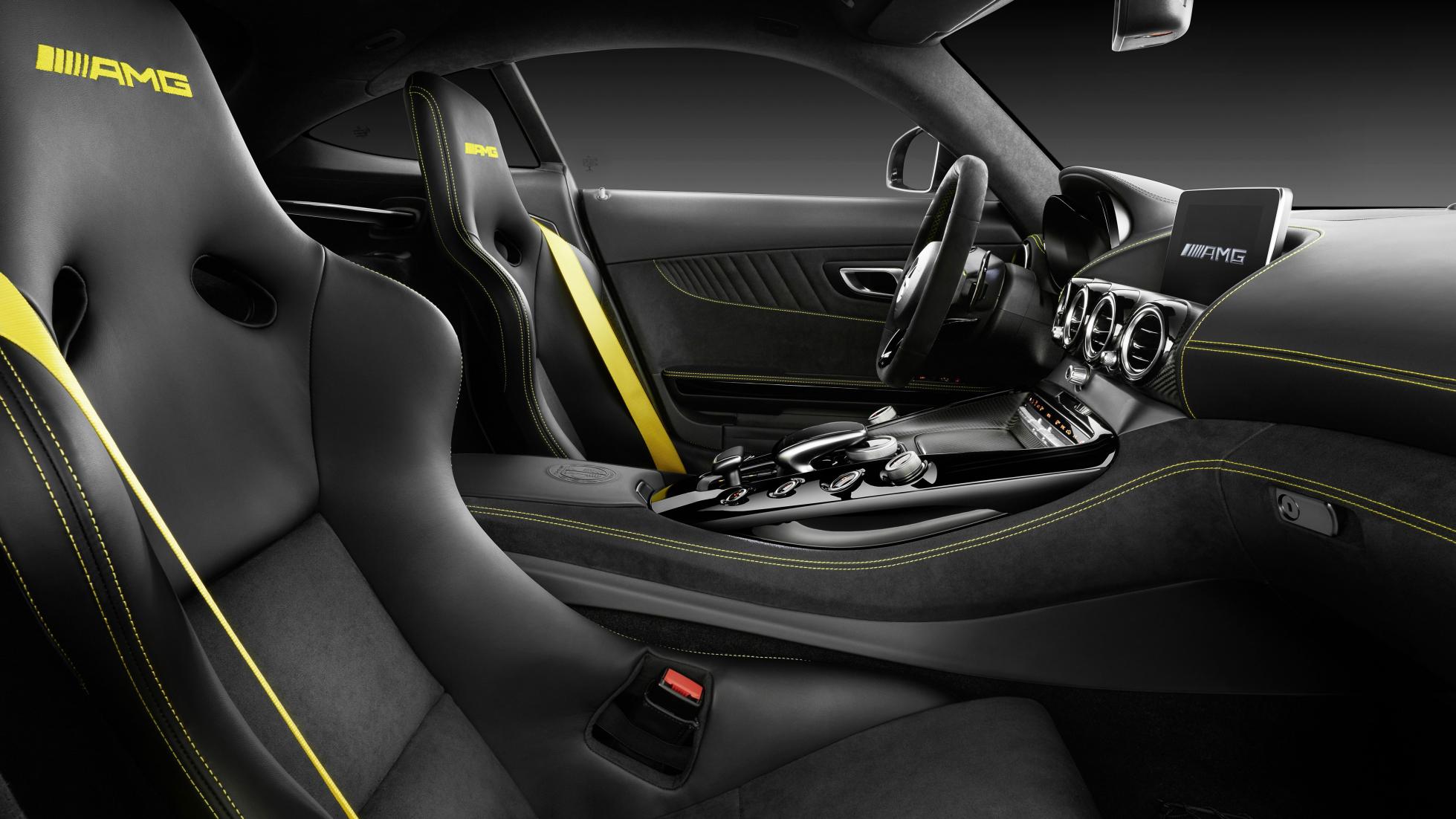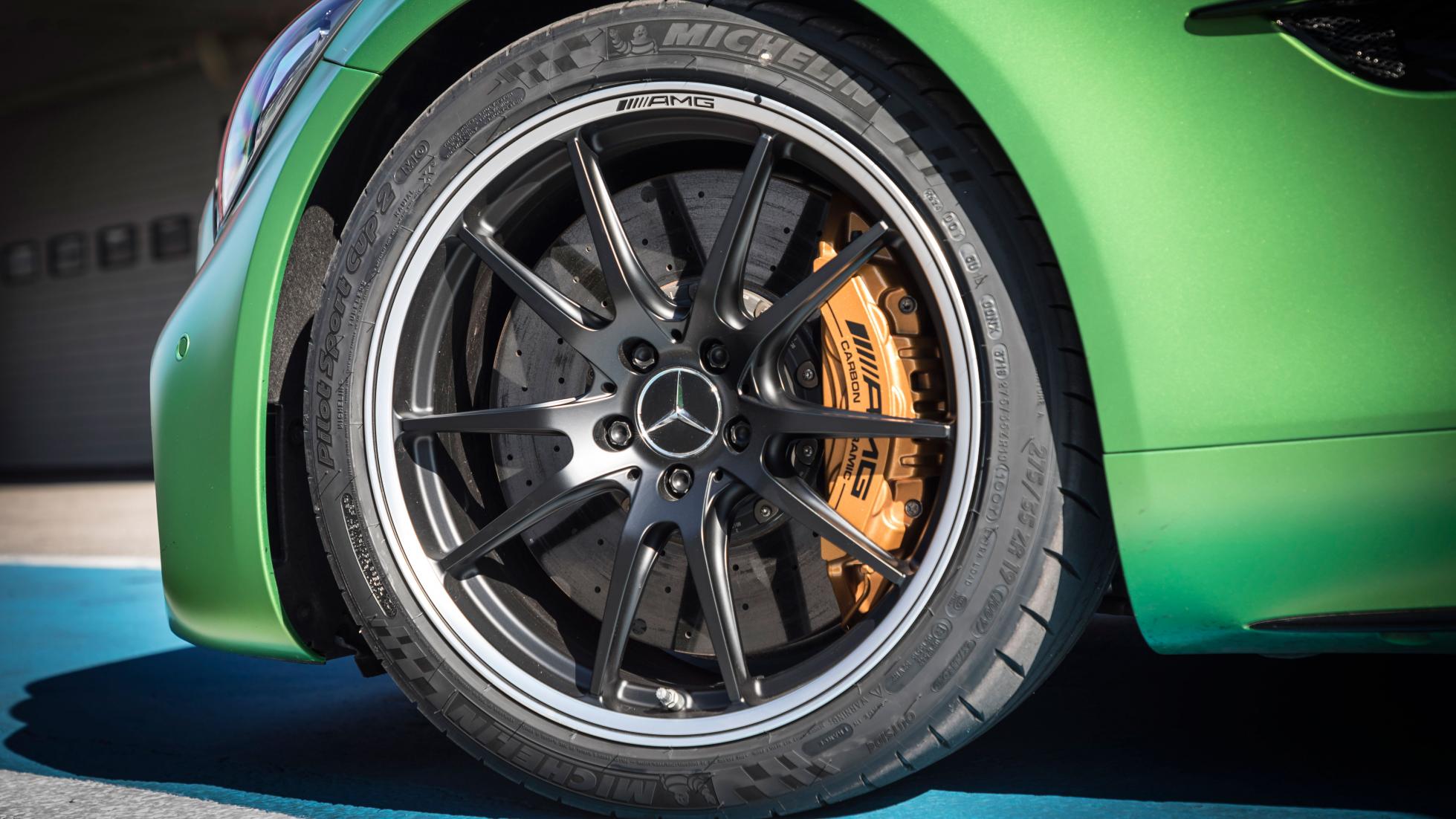“As far as I’m concerned, there is no better sounding turbocharged car. The GT R makes a colossal noise…”

Got stance, hasn’t it?
From where I’m standing the Mercedes-AMG GT R is pure intimidation: fat, wide, low and aggressive. Commendably like the GT3 racer, in fact.
So which came first, racer or road car?
Neither – they have very little in common. The GT R is a development of the GT S road car, not a detuned racing car. Having said that, if you’ve caught a sniff of Nurburgring lap times recently, you might be aware that a GT R has just got itself round there in 7min 10sec, which Merc claims is a record for rear-wheel drive cars. Hmm. A Radical SR8 LM has got itself around in 6min 48secs and although they never published the result, we’ve no reason to doubt McLaren’s P1 dipped below the 7min mark.
But leaving all that aside, a 7min 10secs lap is astonishingly rapid for a comparatively civilised road car. Quicker than a Viper ACR or Corvette ZR1 (surely the closest in layout and ethos to the Merc), only just adrift of a Nismo GT-R. This is good, it proves there’s more to the AMG GT R than doing big, smoky slides.

But is it really a track car?
That’s what we’re here to find out. For a kick off, the amount of work that’s gone into it is deeply impressive. Let me run you through the basics before I tell you about it in detail.
There’s now four-wheel steering, carbon fibre body panels, moving underbody aero elements, another 74bhp from the twin turbo V8, fully redesigned suspension, extra supports to boost torsional rigidity, nine-position traction control that promises Ferrari-style controlled skidding, adjustable coil over spring/damper units, standard Michelin Pilot Sport Cup 2 tyres…
Woah, steady on, I have brain ache…
You and me both. A dizzying amount of work has been done to justify the £31,750 price increase here. The aim is to make the GT R a more focused and rewarding car to drive than the GT S. That’s something I wholeheartedly endorse, because I’m not a big fan of the standard AMG GT – it’s a snatchy, fighty car on a bumpy road, aggressive and demanding. You need to have your wits about you at all times because the margin for error, between quick steering and lively back axle, is small.
I know, I know, surely this one’s going to exaggerate those attributes, then. But wait, Merc has previous – when the SLS Black came along, it was a far more tightly controlled and composed car than the rather wayward standard SLS. And when I had a passenger ride in the GT R alongside AMG boss Tobias Moers at Goodwood back in the summer, I came away sensing the GT R felt friendlier, more together.

And is it?
I’m going to keep you holding on a little longer, as I want to do some digging into the technology Merc has shoved under these swollen panels. We’ll start at the front and work back.
So there’s a new nose, inspired by the old 300 SL Gullwing racer that won the Panamericana road race in Mexico in 1952, and largely carried over from the GT3 racer. I’m sure it could be more in-yer-face, but as yet I can’t work out how. Behind the lower airdam are flaps to control airflow, and underneath, still in front of the engine, there’s a carbon fibre panel that lowers itself by 40mm at speed, adding a venturi effect and claiming to reduce front axle lift by 40kg at 250kph.
The front wings are of course new (and made of carbon fibre), to cover the 46mm track width increase. Wider wheels and tyres are held further away from the body by double wishbone, forged aluminium suspension and controlled by new coilover adjustable spring/damper units.
{gallery}MercAMG_GTR_1{/gallery}
Haven’t we got back as far as the engine yet?
We have now. The AMG GT is front mid-engined (the weight distribution is actually a slightly rear-biased 47:53 thanks to the gearbox sitting on the rear axle), and wears a pair of turbos inside the vee of the 4.0-litre eight. The turbochargers are new, boost has been increased from 1.2 bar to 1.35 bar and they can spin up to 186,000rpm – that’s 3,100 revolutions per second fact fans.
Elsewhere in the engine the compression ratio has been altered, the combustion has been remapped, the exhaust ports modified and the cylinder liners now wear the same Nanoslide coating as Lewis’s F1 car to reduce wear and friction. There are dynamic engine mounts, as well – but the GT S has those, too.
A 13.9kg carbon fibre torque tube (40 per cent lighter than the GT S’s aluminium item) surrounds a 4kg carbon driveshaft that takes 577bhp and 700Nm ft rearward to the gearbox – which, you guessed it, has come in for some alterations. First is now longer, seventh shorter and the final drive ratio is lower, too. Shifts are sharper and Race Start (what AMG calls launch control), uses higher revs and a more aggressive strategy.
Rear track widths are up 57mm and again we have new components – a whole new back axle in fact. Including that four-wheel steering system. Two electro-mechanical actuators replace conventional control arms (there’s no mechanical link to the steering wheel), and can alter the toe angle by 1.5 degrees. The idea is to sharpen up turn-in below 100kph by counter-steering, and improve stability above that speed by turning in the same direction.

So it’s a hardcore front-engined, rear-drive coupe with four-wheel steering. Sounds a lot like the Ferrari F12tdf…
But around a third of the price. And hopefully far friendlier to drive than Maranello’s savage. I drove that recently and boy is it… Sorry, digressing. What haven’t I mentioned? Well, there’s a carbon roof, and additional carbon bracing underneath the exhaust (now titanium and 6kg lighter) that improves torsional rigidity by 7.5 per cent. There are two additional diagonal brace beams across the engine bay, too, less sound insulation and the very trick nine position traction system operated by a yellow knob in the middle of the dash.
Anyway, despite all the mods and the chunky rear wing, a fair bit of give and take on the weight means all-up the GT R is 15kg lighter than the GT S. That’s not a bad result, giving it a healthy 371bhp/tonne power to weight ratio – 51bhp/tonne better than the GT S and ballpark compared to rivals such as the McLaren 570S (399bhp/tonne), Audi R8 V10 Plus (387bhp/tonne) and Porsche GT3 RS (346bhp/tonne). I know, the rivals cover a bit of bandwidth, but that’s because the GT R does as well.
So what’s it like to drive?
Way better than the GT S, for starters. Not just around a track, but on the road as well. Let’s start there, in fact, because I think that’s the GT R’s biggest gain. I expected it to be better around a circuit, but hadn’t anticipated just how much more together it would be on the road.
Of course I didn’t fiddle with the suspension settings beyond the usual Comfort/Sport/Sport+ electronic controls, but what struck me was a) how much chassis rigidity had improved, and b) how compliant the ride was. The two aren’t unrelated. A stiffer platform has allowed AMG to soften off the springing. Bucking and pogoing on bumpy roads has been drastically reduced – not completely eradicated because that would be impossible given your backside is pretty much on top of the back axle. You do get some vertical motion, but it’s well controlled by the dampers, and the extra width has enhanced stability.
It’s taut, sharp and agile. You no longer cling on for dear life, but can actually trust the power, grip and chassis poise. It’s not snatchy when you turn in and the rear end follows faithfully. You’re not just travelling faster, but you’re more in control, too. And it’s such an event to drive.
Because of the engine?
That’s a big part of it, yes. As far as I’m concerned, there is no better sounding turbocharged car. The GT R makes a colossal noise, a whooping, hollering, deep V8 bellow that comes up from the very bottom of its engine block. And the thrust that accompanies it is equally impressive.
I know the numbers (0-100kph in 3.6secs) may not sound that awe-inspiring, but for a rear-driver with the engine up front that’s not bad, and the way it punches forward once you’ve got 3,500rpm on the dial is mighty. On the main straight at Portimao it was registering 265kmh (165mph), and still pulling very hard indeed.
With your view out framed by the broad, shallow windscreen and long bonnet, your ears full of trumpeting V8 and the suspension batting away the worst that Portugal’s roads have to offer, the GT R feels very good indeed. It’s not quite up to McLaren 570S or Porsche GT3 RS levels of tactility and poise – largely because it weighs around 150kg more, I suspect, but it’s a different type of car to them.

Not a track car then?
It’s not that, but having the engine up front pulling, rather than pushing, and the heavy mechanicals (engine and gearbox) sited ahead and behind you, rather than all together, does give the GT R a different feel. What has improved markedly is how harmoniously the front and rear axles work together. They don’t in the GT S, but here the link between the two is more rigid, so what you do at one end – steer or accelerate – has an instant effect at the other as well.
This makes it easy to accurately trim your line through corners and place the car on the road. It’s very accurate and although the usual complaint about absent steering feel holds true, you have confidence in the GT R’s behaviour. The variable rack feels pretty natural to use, not artificially sharp, and the brakes (optional ceramic stoppers with 402mm front and 360mm rear discs) are utterly mighty.
Quick mention for the gearbox, too. I didn’t particularly notice the shorter gearing, but left to its own devices on track it made good decisions. When I did the paddle-pulling myself downshifts seemed slightly more hesitant. You demand them even when you don’t need them, just to hear the revs flare once more.
It’s rampant on a circuit, a proper blood-curdling event of a car. It often seems on the verge of running away with you, but has the manners and talent to rescue itself from every situation. It will understeer if you brake too late, but otherwise the nose is sharp and gives tremendous turn-in (thank the 4ws system for that). Through the higher speed stuff, you do get the sense that the more advanced aero is working hard, too.
You can play with the balance through the middle of the corner and the GT R will be alert and responsive, then – depending on where you’ve got the traction control wound to – you can alter your angle of attack at the exit.
Does that nine position traction system make a difference?
Absolutely. Counter-intuitively you have to have the conventional traction fully disabled via a button on the centre console, and then you use the yellow knob to select just how much margin you want. It’s not really a drift control like Ferrari’s SSC, but instead is designed to improve your trajectory and exit speed. Slacken it off too much and you will get pronounced oversteer (577bhp will have that effect), but there’s a happy point just beyond half way round the dial where you have all four wheels working hard and the car neutral. It’s very satisfying.

So what sort of car is it, road or track?
In essence it’s simply a considerably better AMG GT. Maybe with a touch more track emphasis, but essentially with much better manners everywhere. And yes, that does mean Merc still has room in the GT portfolio for a GT Black Series to go chasing the GT3 RS.
But that’s not for now. As for the GT R, I don’t think there are any drawbacks over a GT S – it’s no less practical or any less refined, the seats are fantastic, the driving position low, snug and secure, it rides markedly better and is more stable and driveable.
It’s hugely amusing – slightly less grown up than an Audi R8 or Porsche 911 Turbo, less professional than a McLaren 570S. A proper charger, confident and proud. It knows how to have a good time, but also how to keep control of itself. It’s probably closest in character to a Corvette Z06. So this is not merely a hardcore version of the AMG GT, but a car with enhanced abilities in all areas. I said earlier that I wasn’t a fan of the AMG GT before. I am now.
- Ollie Marriage

Specs
3982cc twin turbo V8, RWD, 577bhp @ 6250rpm, 700Nm @ 1900-5500rpm, 24.8mpg, 259g/km CO2, 0-100kph in 3.6secs, 320kph, 1555kg, 371bhp/tonne, 47:53 weight distribution, £143,245
{gallery}MercAMG_GTR_2{/gallery}
